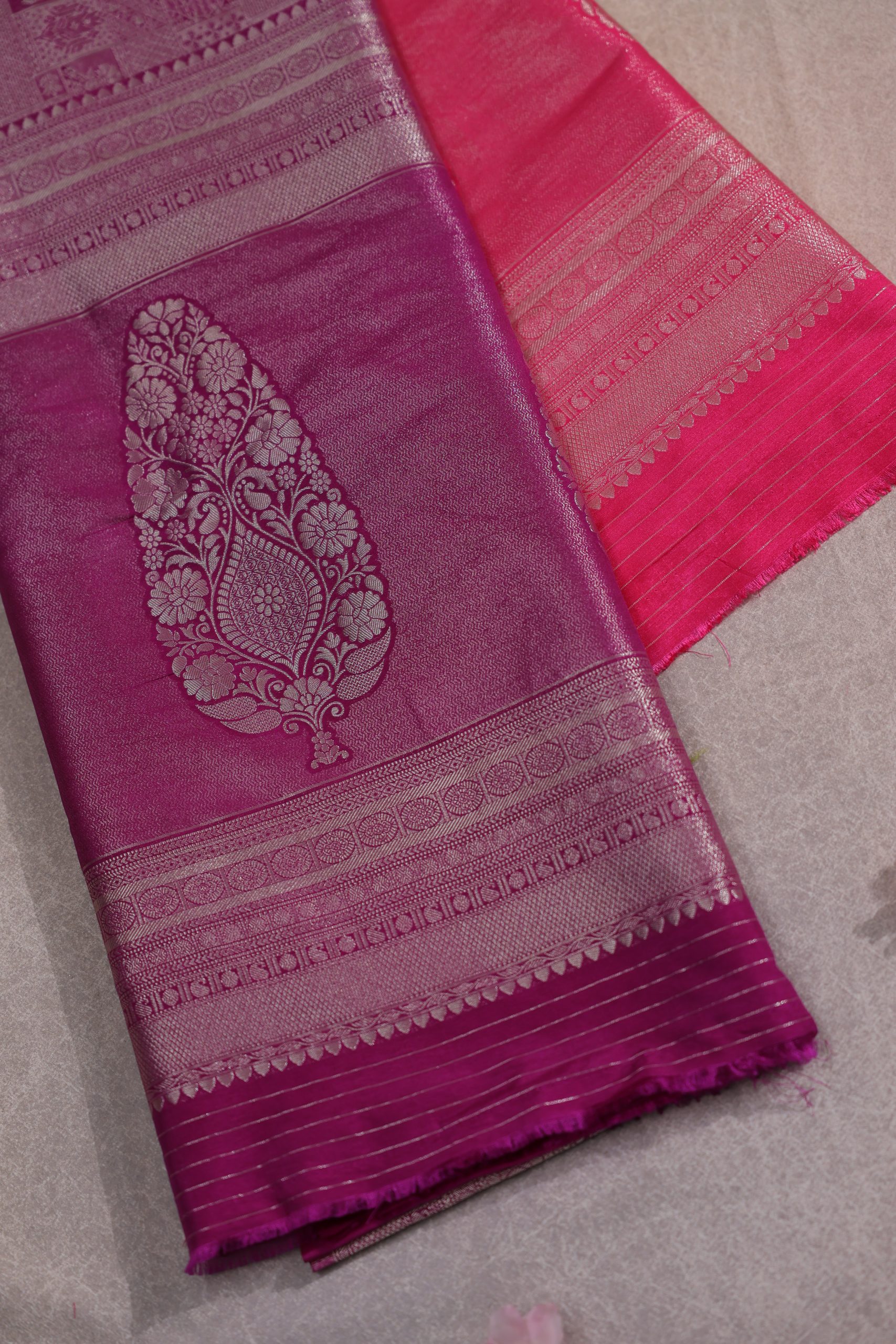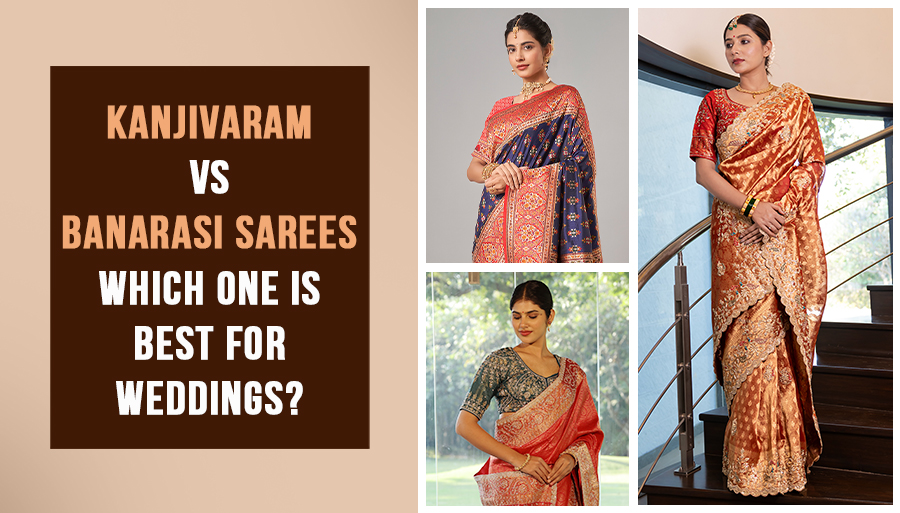Sarees have always been the first fashionwear choice for weddings, symbolizing unmatched. Rooted in Indian tradition, sarees offer various exquisite options representing different designs, fabrics, and styling choices. In Indian culture, the most celebrated saree types that women prefer for weddings are the Kanjivaram and Banarasi sarees. Both represent astute luxury, iconic stylization, and intricate design elements rooted in ages of craftsmanship tradition Kanjivaram vs. Banarasi Sarees.
But selecting any one of them for your wedding fashion can be really as both choices come with a unique look, feel, and aesthetics. This is why here in this blog we are going to explore the details of Kanjivaram and Banarasi sarees and provide handy tips to make the right choice.
Kanjivaram Sarees

Kanjivaram sarees are originally from the town of Kanchipuram in Tamil Nadu. This exquisite saree made of high quality silk fabric is frequently referred to as the “queen of silks.” Kanjeevaram sarees are well known for celebrating exclusive design craftsmanship belonging to the region. Besides design elements what set these sacrées apart is their rich silk fabric, and vibrant colors.
Design Craft and Weaving

Kanjivaram sarees use an authentic rich silk type popularly known as mulberry silk. These sarees showcase intricate zari design work crafted using actual silver or gold. They follow an intricate weaving process requiring a lot of time and time from craftsmen. The skilled artisans creating such sarees even take weeks or months to shape a single saree. Another unique attribute is the frequent use of temple motifs all over the saree. Kanjeevaram sarees also showcase floral designs and detailed geometric patterns.
Vibrant Colors and Contrast

Kanjivaram sarees are also unique for their vibrant color combinations. To make them more captivating, these sarees also use bold patterns. We often see these sarees in traditional maroon, gold, green, and orange hues. But modern variants of these sarees also come with pastel shades and more unconventional color schemes. Generally, the pallu or border of the saree comes with a contrasting color, making it look striking and captivating.
Fabric & Durability

One of the most acclaimed aspects of a Kanjivaram saree is its high-quality silk fabric that ensures unmatched durability. Crafted using thick, high-quality Mulberry silk, these sarees stay at wardrobes for generations and are often passed down from grandmas to granddaughters as heritage fashionwear. Though these sarees add extra weight, the smooth sheen of the silk always makes it comfortable for all seasons. This is why Kanjeevaram is great even for extended wedding ceremonies.
Banarasi Sarees

Banarasi sarees, as the name suggests, are originally from Benares or Varanasi. They are famous for their sparkling grandeur and luxurious feel because of the intricate brocade and zari work. No wonder Banarasi sarees are synonymous with grand wedding appearances for Indian women. Banarasi sarees are always a quintessential part of bridal fashion all over the length and breadth of India.
Design Craft and Weaving

Traditional artisans craft Banarasi sarees and they use extremely rich and delicate silk fabric and create detailed metallic zari design work. Their design patterns and motifs range from Mughal-inspired paisleys to beautiful floral vines to patterns resembling traditional nets used in royal architecture. Each Banarasi saree is creative artwork, and designing it sometimes takes weeks or months of rigorous labor. Just because shaping the complex design takes such huge time and manual effort, Banarasi sarees remain an expensive garment. Based upon the complexity and motifs of design, Banarasi sarees are of different types such as Jangla showcasing dense patterns with floral motifs, Katan designed using pure silk threads, and Tissue offering a translucent look and feel.
Wide Range of Color Choices

Banarasi sarees, unlike the bright and bold hues of Kanjeevaram, can be seen in all types of color combinations. While red and gold remain the most popular bridal choices, soft pastel shades are also widely popular, especially with the combination of modern design motifs. The intricate and overly complicated design patterns often take over an entire saree. The tapestry of zari design work can vary from stark contrast to the well-matched milieu of thread and fabric hues.
Weight & Comfort

Though Banarasi sarees are design-heavy, they offer a lightweight choice compared to the Kanjivaram sarees. They are undoubtedly more popular as designer fashionwear among wedding guests and brides. If you want to balance opulence and weight perfectly, Banarasi sarees bring you an ideal dress choice.
Kanjivaram vs Banarasi: Comparing different attributes
Now that you have a fair idea of the key specialties of Kanjivaram vs. Banarasi Sarees and the grandeur and opulence they bring to Indian weddings, it is important to get into a detailed comparison of their fabric texture, design aesthetics, color choices, cultural milieu, comfort, and versatility.
Texture of the Fabric


Kanjivaram sarees, as we have already mentioned, are created using a thick silk variety from Tamilnadu, which we call Mulberry silk. The sheen of the silk and its luxurious feel make it an indomitable choice for very special occasions like weddings. The heavier texture and the exuberant sheen give these sarees an unmatched regal appeal. Banarasi sarees, in comparison, are more fine as they use delicate silk and fine threadwork all over. With Banarasis, you have a softer and lightweight texture, making it a stylish choice for both wedding guests and brides.
Design Aesthetics


Kanjivaram sarees are rooted in traditional South Indian design aesthetics. They showcase mostly motifs from South Indian temples and natural elements from the South, such as elephants and peacocks. These sarees also showcase motifs inspired by Hindu mythology and culture. Banarasi sarees, in perfect contrast, are rooted more in the Mughal-inspired design traditions of North India. They bring heavy floral and geometric design patterns, creating a shimmering visual effect. This is why Banarasi sarees are preferred for evening weddings and occasions.
Color Palette


Kanjivaram sarees are mostly seen in bold and vibrant hues. These sarees also appear with borders of contrasting colors. Banarasi sarees, in stark contrast, prefer muted colors when appearing in contemporary designs. Regarding bridal wear, you can choose bright hues for both types of sarees.
Cultural Association
Kanjivaram sarees, all over South India, remain the most preferred choice for bridal fashion. They are finely associated with the cultural tradition and heritage of South India. Banarasi sarees, on the other hand, represent a cultural significance that dates back to the Mughal Empire in North India. To date, they are the most preferred bridal fashion choice in North Indian states.
Comfort & Versatility
Kanjivaram sarees, due to their heavy build, are more suitable for events of grandeur like traditional wedding ceremonies. But at the same time, their heavier texture can make these sarees a less likely choice for casual and light-hearted occasions. Banarasi sarees, due to their lightweight build and ease of wearing, are preferred in modern wedding ceremonies involving a lot of activities, songs, and dance. These sarees are also versatile enough to allow pairing with classic jewelry pieces or contemporary accessories.
Which One Is Best for Weddings?
The final choice between Kanjivaram vs. Banarasi Sarees depends on several factors. To be precise, you need to consider the mood and grandeur of the wedding, the cultural backdrop, and finally, your preferences for making a unique fashion statement with a saree.
You should choose Kanjivaram if you prefer to look bold and dashing while remaining rooted in South Indian tradition. Choose Banarasi sarees if you are from North India and prefer a lightweight yet shimmering option rooted in Mughal-era fashion tradition.
Conclusion
In the end, we must mention that both Kanjivaram vs. Banarasi Sarees showcase the master craftsmanship of Indian saree artisans and designers; you cannot find more opulent and sparkling bridal and wedding fashionwear choices rooted in Indian tradition and heritage than these two celebrated saree varieties. While picking any of these timeless sarees, choose the one that aligns with your personality, style, and the wedding occasion.

